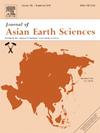Climate-driven microstructural differentiation between loess and paleosol in the Central-Eastern loess Plateau of China
IF 2.7
3区 地球科学
Q2 GEOSCIENCES, MULTIDISCIPLINARY
引用次数: 0
Abstract
Loess-paleosol sequences constitute critical terrestrial archives for reconstructing Quaternary paleoclimatic dynamics. This study integrates paleomagnetic stratigraphy, physicochemical analyses, and high-resolution microstructural characterization to elucidate climate-driven structural differentiation in a typical loess-paleosol sequence from the central-eastern Loess Plateau, China. Three diagnostic distinctions emerge: (1) Particle morphology: loess exhibits loose aeolian stacking with angular particles accompanied by parallel cleavages with pairable contours and the same mineral composition on both sides, contrasting with paleosol’s tight stacking with relatively rounded grains showing chemical weathering features, e.g., dissolution-derived rounded pits; (2) Matrix composition: Loess matrix (<30 vol%) consists primarily of illite-chlorite assemblages forming point contacts, contrasting with paleosol’s enriched matrix (>40 vol%) dominated by secondary calcite and illite–smectite and kaolinite clays that create pervasive cementation; (3) Pore architecture: loess preserves well-aligned macropores with smooth walls, while paleosol develops poorly-aligned irregular micropores infilled with pedogenic materials. These structural divergences reflect fundamentally different formation processes: loessification under cold-arid conditions versus pedogenesis during warm-humid conditions. The systematic microstructure-climate relationships advance mechanistic understanding of East Asian monsoon evolution, demonstrating how loess pedostratigraphy encodes Pleistocene-Holocene environmental transitions through measurable structural responses to atmospheric forcing.
气候驱动的黄土高原中东部黄土与古土壤微观结构分异
黄土-古土壤序列是重建第四纪古气候动力学的重要陆地档案。本研究结合古地磁地层学、物理化学分析和高分辨率显微结构表征,阐明了黄土高原中东部典型黄土-古土壤序列的气候驱动结构分异。(1)颗粒形态特征:黄土表现为松散的风成堆积,颗粒呈棱角状,平行解理,等高线平行,两侧矿物成分相同;古土壤表现为致密堆积,颗粒相对圆润,具有溶蚀形成的圆坑等化学风化特征;(2)基质组成:黄土基质(30%体积%)主要由形成点接触的伊利—绿泥石组合组成,而古土壤富集基质(40%体积%)主要由次生方解石、伊利—蒙脱石和高岭石粘土组成,形成普遍的胶结作用;(3)孔隙结构:黄土保留排列整齐、壁光滑的大孔,古土壤发育排列不整齐、不规则的微孔,微孔中充满成土物质。这些构造差异反映了根本不同的形成过程:寒冷干旱条件下的黄土化与温暖潮湿条件下的成土作用。系统的微观结构-气候关系促进了对东亚季风演化的机制理解,证明了黄土土壤地层学如何通过可测量的结构对大气强迫的响应来编码更新世-全新世的环境转变。
本文章由计算机程序翻译,如有差异,请以英文原文为准。
求助全文
约1分钟内获得全文
求助全文
来源期刊

Journal of Asian Earth Sciences
地学-地球科学综合
CiteScore
5.90
自引率
10.00%
发文量
324
审稿时长
71 days
期刊介绍:
Journal of Asian Earth Sciences has an open access mirror journal Journal of Asian Earth Sciences: X, sharing the same aims and scope, editorial team, submission system and rigorous peer review.
The Journal of Asian Earth Sciences is an international interdisciplinary journal devoted to all aspects of research related to the solid Earth Sciences of Asia. The Journal publishes high quality, peer-reviewed scientific papers on the regional geology, tectonics, geochemistry and geophysics of Asia. It will be devoted primarily to research papers but short communications relating to new developments of broad interest, reviews and book reviews will also be included. Papers must have international appeal and should present work of more than local significance.
The scope includes deep processes of the Asian continent and its adjacent oceans; seismology and earthquakes; orogeny, magmatism, metamorphism and volcanism; growth, deformation and destruction of the Asian crust; crust-mantle interaction; evolution of life (early life, biostratigraphy, biogeography and mass-extinction); fluids, fluxes and reservoirs of mineral and energy resources; surface processes (weathering, erosion, transport and deposition of sediments) and resulting geomorphology; and the response of the Earth to global climate change as viewed within the Asian continent and surrounding oceans.
 求助内容:
求助内容: 应助结果提醒方式:
应助结果提醒方式:


